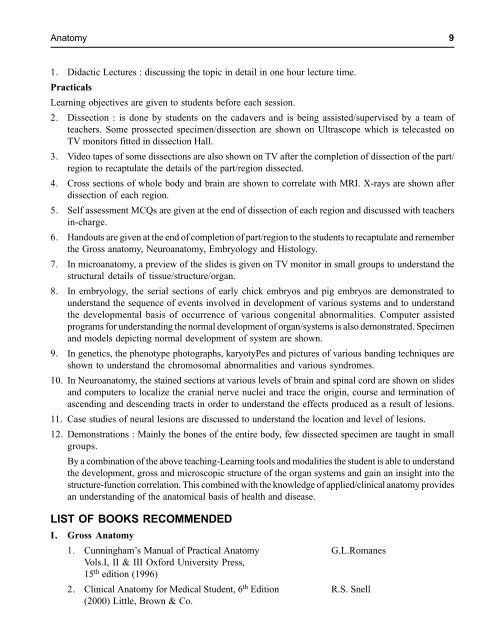Syllabus - MBBS
Create successful ePaper yourself
Turn your PDF publications into a flip-book with our unique Google optimized e-Paper software.
Anatomy 9<br />
1. Didactic Lectures : discussing the topic in detail in one hour lecture time.<br />
Practicals<br />
Learning objectives are given to students before each session.<br />
2. Dissection : is done by students on the cadavers and is being assisted/supervised by a team of<br />
teachers. Some prossected specimen/dissection are shown on Ultrascope which is telecasted on<br />
TV monitors fitted in dissection Hall.<br />
3. Video tapes of some dissections are also shown on TV after the completion of dissection of the part/<br />
region to recaptulate the details of the part/region dissected.<br />
4. Cross sections of whole body and brain are shown to correlate with MRI. X-rays are shown after<br />
dissection of each region.<br />
5. Self assessment MCQs are given at the end of dissection of each region and discussed with teachers<br />
in-charge.<br />
6. Handouts are given at the end of completion of part/region to the students to recaptulate and remember<br />
the Gross anatomy, Neuroanatomy, Embryology and Histology.<br />
7. In microanatomy, a preview of the slides is given on TV monitor in small groups to understand the<br />
structural details of tissue/structure/organ.<br />
8. In embryology, the serial sections of early chick embryos and pig embryos are demonstrated to<br />
understand the sequence of events involved in development of various systems and to understand<br />
the developmental basis of occurrence of various congenital abnormalities. Computer assisted<br />
programs for understanding the normal development of organ/systems is also demonstrated. Specimen<br />
and models depicting normal development of system are shown.<br />
9. In genetics, the phenotype photographs, karyotyPes and pictures of various banding techniques are<br />
shown to understand the chromosomal abnormalities and various syndromes.<br />
10. In Neuroanatomy, the stained sections at various levels of brain and spinal cord are shown on slides<br />
and computers to localize the cranial nerve nuclei and trace the origin, course and termination of<br />
ascending and descending tracts in order to understand the effects produced as a result of lesions.<br />
11. Case studies of neural lesions are discussed to understand the location and level of lesions.<br />
12. Demonstrations : Mainly the bones of the entire body, few dissected specimen are taught in small<br />
groups.<br />
By a combination of the above teaching-Learning tools and modalities the student is able to understand<br />
the development, gross and microscopic structure of the organ systems and gain an insight into the<br />
structure-function correlation. This combined with the knowledge of applied/clinical anatomy provides<br />
an understanding of the anatomical basis of health and disease.<br />
LIST OF BOOKS RECOMMENDED<br />
I. Gross Anatomy<br />
1. Cunningham’s Manual of Practical Anatomy G.L.Romanes<br />
Vols.I, II & III Oxford University Press,<br />
15 th edition (1996)<br />
2. Clinical Anatomy for Medical Student, 6 th Edition R.S. Snell<br />
(2000) Little, Brown & Co.



